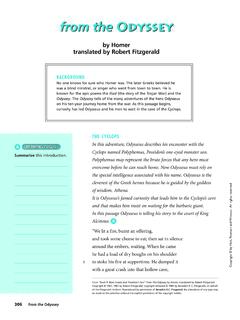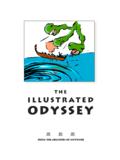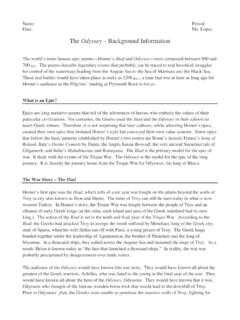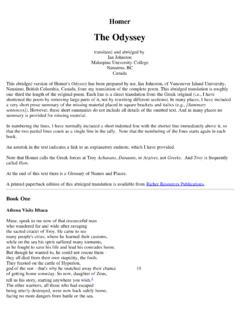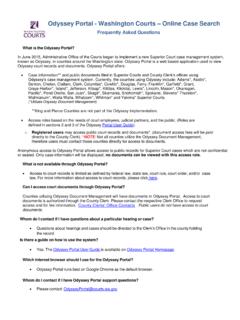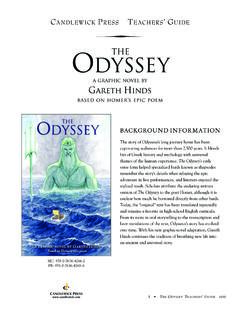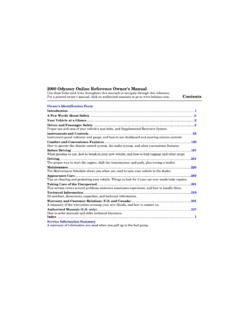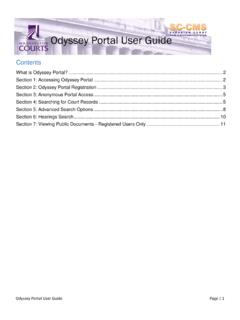Transcription of StudySync LP - The Odyssey
1 Page 1 Lesson Plan: The Odyssey Objectives 1. Engage students in the plot, characters, themes, setting, and language of Homer's The Odyssey so that they are prepared to discuss and write about the excerpt. 2. Practice and reinforce the following Grade 9-10 ELA Common Core Standards for reading literature, writing, and speaking/listening: READING: LITERATURE - , 9-10 WRITING - , 4-6, 7-10 SPEAKING/LISTENING - Time 160 minutes (with up to an additional 140 minutes of extension possibilities) Materials SyncTV Premium Lesson of Homer's The Odyssey (translated by Samuel Butler) Overview Along with its prequel (of sorts), The Iliad, Homer's The Odyssey is considered to be the oldest still-surviving work in the entire canon of Western literature. Though next to nothing is known about the author (some speculate that Homer was not a single individual but a series of different authors), the epic poem has been translated into hundreds of different languages, and is one of the most widely read and influential stories in our literary history.
2 It is centered on a Greek hero, Odysseus, and his ten-year journey home after the fall of Troy--an episodic journey fraught with peril, adventure, and fantastical encounters across mythical lands. This excerpt shows how Odysseus is caught between the human failings of his men and the inescapable vengeance of the gods. Close examination of this text will prepare students to develop thoughtful responses to higher-level literary texts, and to write thoughtful, informed, and textually-rooted responses, consistent with the ELA Common Core Standards for the high school grades. Background (15 minutes) 1. Watch the Preview ( ). As a group, watch the video preview of the premium lesson. Use the following questions to spur discussion following the preview: StudySync Lesson Plan The Odyssey Page 2 Lesson Plan: The Odyssey a. What does the word Odyssey mean? What kinds of images and emotions does it conjure? b. Which elements mentioned in the preview are based on actual or plausible historical events?
3 Which elements are fantasy? How does this story blend fact with fantasy? What effects does this have? c. Listen to the music and consider the images in the preview. In what other stories or films have you encountered images like these? Extension (additional 30 minutes) d. Research and Discuss ( , ). The preview mentions the Trojan War, the fall of Troy, and the heroes' voyage home to Ithaca. Discuss, as a class, what is commonly known about these historical events. Who fought in the Trojan War? Who won? Where is Ithaca? Where must Odysseus be from? e. Write Creatively ( ) Invite students to draw or write their own interpretation of the hazards Odysseus faces, based on the images in the preview storms, wind, sea monsters, goddesses, the Sirens, the Cyclops and other dangers they imagine will happen. Engaging the Text (145 minutes) 2. Read the Text (30 minutes) a. Read and Annotate ( ). As students read the excerpt from The Odyssey , have them annotate the text with any questions or responses they may have.
4 If your classroom has a projector, model note-taking and annotating skills, using the first paragraph as an example. Student responses are visible to you after students submit their writing assignments or beforehand if using the mimic function to access students accounts. b. Discuss ( ). Have students meet in small groups or pairs and briefly discuss the questions and inferences they had while reading. As a class, discuss the following: How did the images in the preview affect your understanding of the text? What other images came to mind as you read the excerpt? How has your sense of the excerpt s themes changed now that you ve read it? What words were new to you? What meanings did you infer? Extension (additional 20 minutes) c. Listen and Discuss ( , ). As a class, listen to the audio reading of the text. Discuss: How does the experience of listening to The Odyssey differ from reading it on the page? What events does the author use to develop the characters and setting?
5 D. Comprehend ( , 4 5). Have students complete the multiple-choice questions. Collect papers or discuss answers as a class. 3. Watch SyncTV (40 minutes) a. Watch. Either watch the SyncTV discussion associated with The Odyssey as a class or ask students to watch it on their individual computers. Page 3 Lesson Plan: The Odyssey b. Focus ( , , 5) From 3:40-5:20, the SyncTV students discuss the literary concept of allegory, and explore The Odyssey 's allegorical meaning. Have students focus on the SyncTV students' interpretations, and consider their own ideas. Think of what is being represented, both by the individual characters and the story as a whole. c. Focus ( , ). In the portion of the episode from 5:45-7:00, the students discuss the philosophy of humanism the idea that reason and logic dictate the workings of the world as it relates to Odysseus, the hero of The Odyssey . Review the discussion of Odysseus' heroic traits. Ask: what makes Odysseus a hero?
6 What is his responsibility as a hero, if any? d. Focus ( , ) From 7:30-8:25, students discuss the relevance of The Odyssey both then and now. Have students consider the discussion in the episode: why was The Odyssey thematically important in ancient Greece, and why does it continue to be important now? e. Discuss ( and ). After watching the model discussion, have a conversation with the class about the ideas discussed in the episode that stood out the most. What new thoughts do they have after hearing the SyncTV discussion? Next, divide students into small groups (3-4 students). Move around the room monitoring the groups as students follow the SyncTV episode as a model to discuss some of the following questions: 1. What is a hero, and why is Odysseus a classical hero? What heroic attributes does Odysseus possess? Have students list the traits that make Odysseus a hero. 2. Are the gods good, or bad, or neither? What is their role in the story? Are they all-powerful, or is there anything (a character, or an idea?)
7 That is more powerful? Can anything possibly stand in the way of their will? 3. Is The Odyssey an allegory, and if so, what larger ideas or concepts do the characters and situations represent? Especially consider Odysseus, Eurylochus, the men and the god as well as the larger narrative of the story. 4. Whose perspective is this story told from? When is it being told? To whom do you think the narrator is speaking? 5. Though it is thousands of years old, does The Odyssey have any thematic relevance today? Is this story truly timeless, as Marcus attests? How can we see its influence in popular modern works? 6. Compare/contrast fact vs. fantasy as it appears in the text. Which places/events in the excerpt are real? Which are fantasy? Which are believable, and which are impossible? Extension (additional 20 minutes) f. Write ( , 4-6). Use the StudySync assignment creation tool to create a Writing assignment that asks students to address the following prompt: 1.
8 There are at least two dozen different English translations of The Odyssey from Ancient Greek, in both poetry and prose. Think about how a translation into a different language, genre, or medium might affect the telling of The Odyssey . What kinds of Page 4 Lesson Plan: The Odyssey choices and/or changes does a translator need to make? Write an essay about how The Odyssey might be different today than it was thousands of years ago? Think about factors such as audience, technology, and culture. 4. Think (10 minutes) a. Respond ( 2). Ask students to read the Think questions, watch the corresponding video clips, and respond to the questions, either in class or for homework. 5. Write (50 minutes) a. Discuss ( ). Read the prompt you have chosen for students, and then solicit questions regarding the prompt or the assignment expectations. Whichever prompt you have chosen, make sure you are clear about the assignment expectations and the rubric by which you and the other students will be evaluating them.
9 B. Organize ( and , 4). Ask students to go back and annotate the text with the prompt in mind. They should be organizing their thoughts and the points they ll address in their writing as they make annotations. If you ve worked on outlining or other organizational tools for writing, this is a good place to apply them. c. Write ( , 4-6, 9-10). Have students go through the writing process of planning, drafting, revising, editing, and publishing their writing responses. d. Review ( ). Use the StudySync Review feature to have students complete one to two evaluations of their peers work based on your chosen review rubric. Have the students look at and reflect upon the peer evaluations of their own writing. What might you do differently in a revision? How might you strengthen the writing and the ideas? Extension (additional 30 minutes) e. Self-Assess ( ). Use the StudySync assignment creation tool to create a Writing assignment that asks students to address the following prompt: 1.
10 Reread your essay and the reviews of your essay on The Odyssey . After reading these reviews, what do you believe were the biggest strengths of your essay? What could you do better next time? If you were to go back and write this essay again, what would you change about your writing process? How has writing this essay made you a better writer? Extension (additional 50 minutes) f. Write ( , 4-6, 9-10). For homework, have students write a persuasive essay using the following prompt:. 1. Taking either the perspective of Eurylochus and the men or the gods, write a persuasive essay defending the actions your characters carried out in this excerpt from The Odyssey . Page 5 Lesson Plan: The Odyssey Have students outline their essays before they begin. Walk students through the expectations of basic 5-paragraph persuasive essay outlining: 2. Choose the side you are arguing for. 3. Develop the argument into a solid thesis statement. 4. Outline three supporting examples for your argument.

